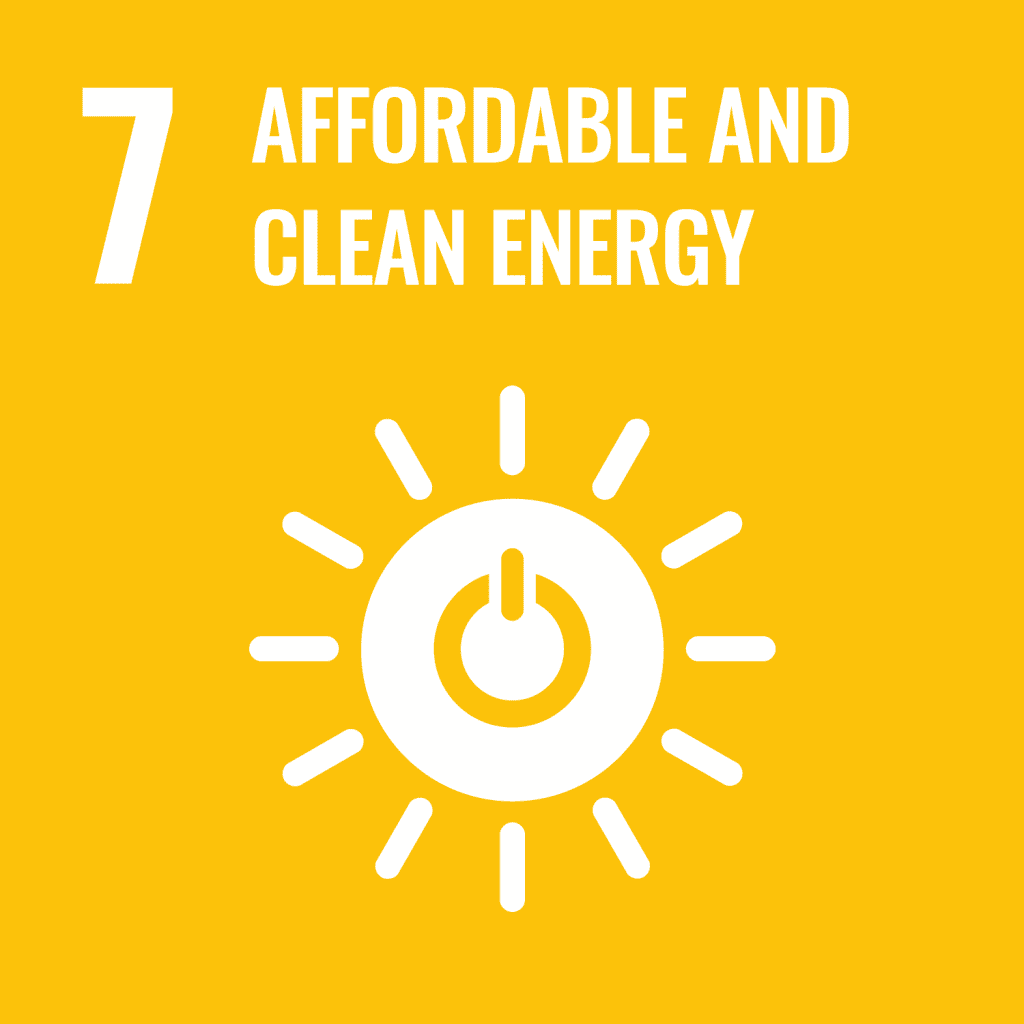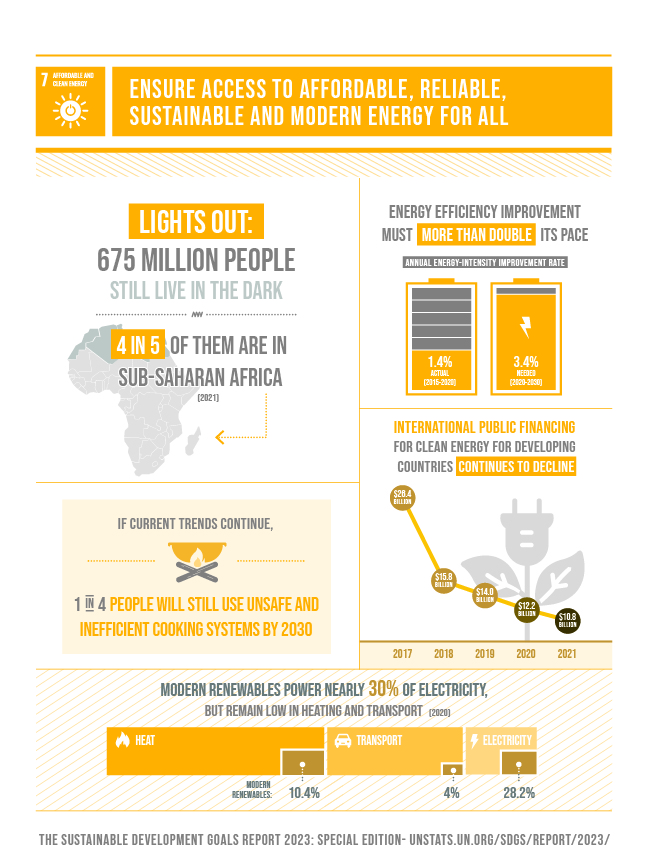Analysis on SDG 7 Affordable and clean energy
The 17 Sustainable Development Goals (SDGs) are deeply interconnected, and when acting on one, we are also affecting the others.
As stated in the 2030 Agenda: “The interlinkages and integrated nature of the Sustainable Development Goals
are of crucial importance in ensuring that the purpose of the new Agenda is realized. If we realize our ambitions across the full extent of the Agenda, the lives of all will be profoundly improved and our world will be transformed for the better.”
I will explain this concept with a detailed analysis of SDG 7 Affordable and clean energy, basic service, and stepping stone of sustainable development. And energy is central to achieving the Paris Agreement on Climate Change as we transition toward net-zero emissions.
You might be wondering why I am starting with SDG 7. I have been interested in access to energy since 2011 when former UN Secretary-General Ban Ki-moon launched the Sustainable Energy for All initiative.

SDG 7 aims to ensure access to affordable, reliable, sustainable and modern energy for all. It has five targets and several indicators to track the progress.
Target 7.1 By 2030, ensure universal access to affordable, reliable and modern energy services.
Indicator 7.1.1 Proportion of population with access to electricity.
Since electricity is a basic service, this goal is connected to SDG 1 No Poverty (e.,g., 1.4.1 increasing proportion of the population living in households with access to basic services). Access to reliable energy means economic development (green jobs) so that individuals have access to new employment opportunities SDG 8 Economic growth. Access to energy means powering healthcare facilities SDG 3 Good Health and Well-being and supplying clean water for essential hygiene SDG 6 Clean Water and Sanitation.
Access to electricity means that children can do their homework at night,whichs means that we are affecting SDG 4 Quality Education. And education is crucial for girls and women on the pathway toward SDG 5 Gender Equality.
Indicator 7.1.2 Proportion of population with primary reliance on clean fuels and technology.
The use of dirty fuels causes indoor air pollution (smoke), so this goal is connected to SDG 3 Good Health and Well-being (e.g., 3.9.1 Mortality rate attributed to household and ambient air pollution). The effects are affecting mainly women and kids that spend more time indoors.
Target 7.2 By 2030, increase substantially the share of renewable energy in the global energy mix.
Indicator 7.2.1 Renewable energy share in the total final energy consumption.
This indicator means that we are increasing the percentage of clean energy in the total final energy consumption, and this is connected to SDG 13 Climate Change because we are reducing greenhouse gas emissions (in particular CO2 emissions). We all can play a role and switch to renewable energy. The reduction of GHG means less air pollution, which is correlated to SDG 11 Sustainable Cities and Communities (e.g., indicator 11.6.2, to reduce the adverse environmental impacts related to air pollution, especially PM 2.5, particles less than 2.5 microns coming from combustion).
Target 7.3 By 2030, double the global rate of improvement in energy efficiency.
Indicator 7.3.1 Energy intensity measured in terms of primary energy and GDP.
When we increase energy efficiency, we reduce energy consumption, which means reducing our emissions, SDG 13 Climate Change. It also means more sustainable cities and communities (SDG 11).
Target 7.a By 2030, enhance international cooperation to facilitate access to clean energy research and technology, including renewable energy, energy efficiency and advanced and cleaner fossil-fuel technology, and promote investment in energy infrastructure and clean energy technology.
Indicator 7.a.1 International financial flows to developing countries in support of clean energy research and development and renewable energy production, including in hybrid systems.
I truly believe that this indicator is crucial in understanding the origin of the Climate Justice concept. It recognizes that the wealthiest countries, historically major contributors of GHG emissions, must help developing countries & communities on the frontlines to access clean energy technologies so they can develop fossil-free within the planetary boundaries (remember that we have only one planet).
What we call “climate finance” is not only a moral imperative. It is necessary if we want to keep this planet habitable.
Target 7.b By 2030, expand infrastructure and upgrade technology for supplying modern and sustainable energy services for all in developing countries, in particular least developed countries, small island developing States and landlocked developing countries, in accordance with their respective programmes of support.
Indicator 7.b.1 Installed renewable energy-generating capacity in developing countries (in watts per capita) is the same as in SDG 12 Responsible Consumption and Production (indicator 12.a.1).
And we could go on exploring other connections.
Related SDGs

The very important point to takeaway here is that the SDGs are interconnected because they act on all dimensions of sustainability to create a path towards a better future for all. They are also indivisible, meaning that we need to treat them in their entirety instead of approaching them as a menu list of individual goals. This is especially relevant when you want to align your business to the SDGs. The first thing to do IS NOT to choose/pick one or more SDGs, but it is to minimize the most significant negative impacts and maximize the positive contributions that your business is having on people and the planet.
“Energy is defined as the ability to do work and it has become increasingly clear that energy is indispensable in achieving sustainable development. In particular, access to affordable, reliable, sustainable, and modern energy is essential for communities and individuals all over the world to achieve their developmental goals.“
Global Expert Group Meeting in Support of the Mid-Point Review of SDG 7 at the HLPF 2023
What’s the progress on Goal 7?
If you want to know more about the progress on SDG 7, below is an infographic with an overview, as you can find on the UN SDGs website and more details on the Sustainable Development Goals Report 2023.

What is the plan to achieve Goal 7?
The UN global roadmap for the achievement of SDG 7 is a plan for transformative action to address the twin energy challenges: ensuring access to clean and affordable energy services for all by 2030 and accelerating the energy transition towards net-zero emissions by 2050.
The global roadmap includes two sets of milestones for 2025 and 2030 (extract from the roadmap)
2025
• 500 million more people have gained access to electricity.
• Annual investment in access to electricity increased to US$ 35 billion and in access to clean cooking increased to US$ 25 billion.
• 100% increase in modern renewables capacity globally.
• Double annual investment in renewable energy and energy efficiency globally.
• No new coal power plans in the pipeline after 2021.
• Fossil fuel consumption subsidies re-directed towards renewable energy and energy efficiency.
• 30 million jobs in renewable energy and energy efficiency.
2030
• Universal access to electricity and clean cooking solutions.
• Triple global renewable power capacity.
• Double the global rate of improvement in energy efficiency.
• Triple annual investment for renewable energy and energy efficiency globally.
• Phase out coal power plans within the OECD by 2030 and globally by 2040.
• 60 million jobs in renewable energy and energy efficiency.
• Universal access to electricity in all healthcare facilities and all schools worldwide.
Climate action as a sustainable development issue affecting all the 17 SDGs
Another example to explain the interconnected nature of the SDGs is by analyzing Goal 13 Climate Action, and how it affects the success of all the 17 Sustainable Development Goals (SDGs).
More resources
The global roadmap to achieve clean energy for all by 2030;
Sustainable Energy for All initiative;
SDG 7 from the UN SDGs website;
Progress on the SDGs in the Sustainable Development Goals Report 2022.
